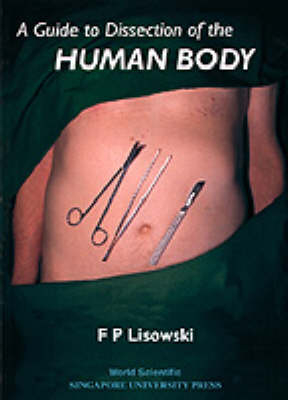
Guide To Dissection Of The Human Body, A
Seiten
1998
World Scientific Publishing Co Pte Ltd (Verlag)
978-981-02-3569-7 (ISBN)
World Scientific Publishing Co Pte Ltd (Verlag)
978-981-02-3569-7 (ISBN)
The focus of this text is on practical applications of infrared characterization useful to the production line and to the research and development of microelectronics. The background knowledge and significance of doing a particular type of infrared measurement is discussed in detail.
This invaluable manual is intended to guide and facilitate human anatomical dissections. It is flexible enough for use in long as well as short courses, and is thus structured in such a way that the dissection of the body can be completed in 110 to 160 hours. Although some medical schools have reduced the amount of dissection, the North American schools have lengthened their courses. The manual can also be used in those courses where only part of the body is dissected and even in the study of prosected material. It can be particularly useful as a link with real anatomy when used together with computerised-anatomy programs; many curricula emphasise that the student should go back and forth between the body and computer programs. The guide is also useful where students do not dissect but merely look at atlases, prosections and models, by providing a link to real, living and variable anatomy.Nowadays many anatomy courses are aimed solely at systems anatomy. Although important as systems are, regions are clinically vital since many more problems concern damage to several systems because the lesions are regional. This is where the guide is of considerable help.There is an introduction for each anatomical region; and for each section to be dissected there is an overview, a dissection schedule which guides the student through a set of instructions, a summary and a list of objectives that are clinically important. The terminology used is the latest.This manual is suitable for medical, dental, osteopathy and chiropody schools as well as human biology and science programs that include dissection in their undergraduate gross anatomy course. It is also of value for advanced knowledge of anatomy for surgery as required by further qualifications and in relation to specialised training involving interpretation of normal anatomy in non-invasive imaging of anatomy for clinical diagnosis, practice of clinical (surgical) skills on cadaveric material, and in discussions about clinical problems.
This invaluable manual is intended to guide and facilitate human anatomical dissections. It is flexible enough for use in long as well as short courses, and is thus structured in such a way that the dissection of the body can be completed in 110 to 160 hours. Although some medical schools have reduced the amount of dissection, the North American schools have lengthened their courses. The manual can also be used in those courses where only part of the body is dissected and even in the study of prosected material. It can be particularly useful as a link with real anatomy when used together with computerised-anatomy programs; many curricula emphasise that the student should go back and forth between the body and computer programs. The guide is also useful where students do not dissect but merely look at atlases, prosections and models, by providing a link to real, living and variable anatomy.Nowadays many anatomy courses are aimed solely at systems anatomy. Although important as systems are, regions are clinically vital since many more problems concern damage to several systems because the lesions are regional. This is where the guide is of considerable help.There is an introduction for each anatomical region; and for each section to be dissected there is an overview, a dissection schedule which guides the student through a set of instructions, a summary and a list of objectives that are clinically important. The terminology used is the latest.This manual is suitable for medical, dental, osteopathy and chiropody schools as well as human biology and science programs that include dissection in their undergraduate gross anatomy course. It is also of value for advanced knowledge of anatomy for surgery as required by further qualifications and in relation to specialised training involving interpretation of normal anatomy in non-invasive imaging of anatomy for clinical diagnosis, practice of clinical (surgical) skills on cadaveric material, and in discussions about clinical problems.
Introduction to infrared spectroscopy; the properties of infared transparent substrates; the measurement of oxygen and carbon in silicon; the calculation of epitexial layer thickness; the characterization of silicon dioxide and silicon nitride thin films; the characterization of PSG and BPSG; the characterization of amorphous silicon and related materials; miscellaneous applications of infrared spectroscopy in microelectronics.
| Verlagsort | Singapore |
|---|---|
| Sprache | englisch |
| Themenwelt | Studium ► 1. Studienabschnitt (Vorklinik) ► Anatomie / Neuroanatomie |
| Technik ► Elektrotechnik / Energietechnik | |
| ISBN-10 | 981-02-3569-0 / 9810235690 |
| ISBN-13 | 978-981-02-3569-7 / 9789810235697 |
| Zustand | Neuware |
| Informationen gemäß Produktsicherheitsverordnung (GPSR) | |
| Haben Sie eine Frage zum Produkt? |
Mehr entdecken
aus dem Bereich
aus dem Bereich
Struktur und Funktion
Buch | Softcover (2021)
Urban & Fischer in Elsevier (Verlag)
CHF 61,60
Buch | Hardcover (2022)
Urban & Fischer in Elsevier (Verlag)
CHF 307,95
+ Web + Lehrbuch
Buch | Hardcover (2022)
Urban & Fischer in Elsevier (Verlag)
CHF 348,55


